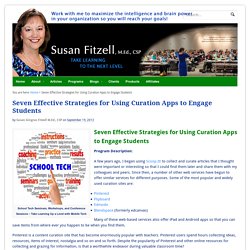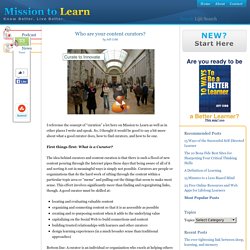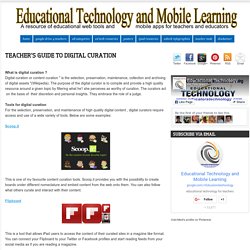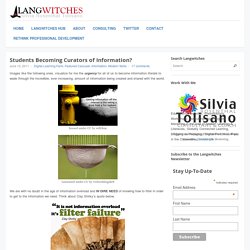

Curating - Teachernology. Seven Effective Strategies for Using Curation Apps to Engage Students. School Tech Seminars, Workshops, and Conference Sessions – Take Learning Up a Level with Mobile Tech Seven Effective Strategies for Using Curation Apps to Engage Students Program Description: A few years ago, I began using Scoop.It!

Content Curation: Learning from others and sharing their knowledge. Over the past few months the subject of content curation has been coming up more often.

Some of you have actually been curating content for years, others are just hearing about it, so it seems a good topic for discussion. Curators at the Cleveland Museum of Art took care to select the right pieces, placement and accompanying art when re-doing the museum's Armor Court. The process of content curation is pretty simple.
Basically one reads a variety of blogs, articles and sites on a given topic, then picks out the best ones to share, just as an editor might choose the most appropriate stories for an anthology of fiction, or a museum curator might choose the right combination of paintings for an exhibit. In the early days of blogging, the process of choosing and sharing links to various noteworthy sites, was one of the most popular ways to blog. Why curate content? I learn in the process. Content Curation Through the SAMR Lens - Getting Smart by Susan Oxnevad - curate content, Flexible Tools, Innovation, multimedia, SAMR Model, Teaching, ThingLink.
Siemens. Who are your curators? I reference the concept of “curation” a lot here on Mission to Learn as well as in other places I write and speak.

So, I thought it would be good to say a bit more about what a good curator does, how to find curators, and how to be one. First things first: What is a Curator? The idea behind curators and content curation is that there is such a flood of new content pouring through the Internet pipes these days that being aware of all of it and sorting it out in meaningful ways is simply not possible. Curators are people or organizations that do the hard work of sifting through the content within a particular topic area or “meme” and pulling out the things that seem to make most sense. This effort involves significantly more than finding and regurgitating links, though. Bottom line: A curator is an individual or organization who excels at helping others make sense.
For the individual lifelong learner, I see (at least) two powerful opportunities here. The first is to find great curators. Jeff. Flintoff. Research: 9 in 10 Teachers Don't Use Social Media in the Classroom. Social Media Research: 9 in 10 Teachers Don't Use Social Media in the Classroom Nearly nine of 10 — 87 percent — of teachers have not incorporated social media into their classrooms, according to a new survey conducted by Harris Poll on behalf of the University of Phoenix.

The survey also found that more teachers, 62 percent, said they are reluctant to incorporate social media in their classrooms than in 2013, when 55 percent reported such hesitation. Only 44 percent of teachers surveyed said that social media can enhance a student's educational experience. "A lack of tools and training top the list of educator concerns," according to a news release. A majority, 82 percent, also reported that they worry about conflicts that may arise from using social media with students or their parents and 62 percent said that use of personal devices outside the classroom makes it harder for students to pay attention in group settings inside the classroom. About the Author. Teacher's Guide to Digital Curation. What is digital curation ?

Digital curation or content curation " is the selection, preservation, maintenance, collection and archiving of digital assets "(Wikipedia). The purpose of the digital curator is to compile and provide a high quality resource around a given topic by filtering what he'/ she perceives as worthy of curation. The curators act on the basis of their discretion and personal insights. Students Becoming Curators of Information?
Images like the following ones, visualize for me the urgency for all of us to become information literate to wade through the incredible, ever increasing, amount of information being created and shared with the world. licesed under CC by will-lion Lincensed under CC by verbeeldingskr8.

Using Content Curation Tools to Engage Students. When I was in college (for 12 years I might add) there were really only three sources of information available to students: 1) Instructor 2) Textbook 3) Library.

This was not such a distant past. A mere two decades ago I finished my undergrad, and I graduated with my PhD in 2001. Teaching Content Curation Skills to Students. In my last piece, I discussed why content curation was an essential skill and discussed ways teachers could use Pinterest to curate content for students.

Modeling this skill for students is important, but giving them the knowledge to do it themselves is crucial. The ability to sort through many sources for high-quality information was always the goal of library time and research notecards, but today’s students need tech-based content curation skills. Teaching With Content Curation. 21st Century School | Feature Teaching With Content Curation With two mobile laptop carts that are used primarily for technology classes and a student body that has limited access to computers outside of school, Stockton Collegiate International School isn’t exactly a hotbed of ed tech.

That stumbling block doesn’t stop the K-12 charter school in Stockton, CA, from doing what it can to cultivate its 21st Century learners and prepare them for college and the workforce. In Hauna Zaich’s 8th- and 10th-grade English classes, for example, students—a good portion of whom are English learners—are using a process known as “content curation” to cull through the many resources on the web, select the most relevant ones, and then organize those resources in a logical format for sharing and later use. One of Zaich’s curated boards introduces 10th graders to verb tenses, subject/verb agreement, and active versus passive voice to prep them for a writer’s workshop. Flipping the Classroom.